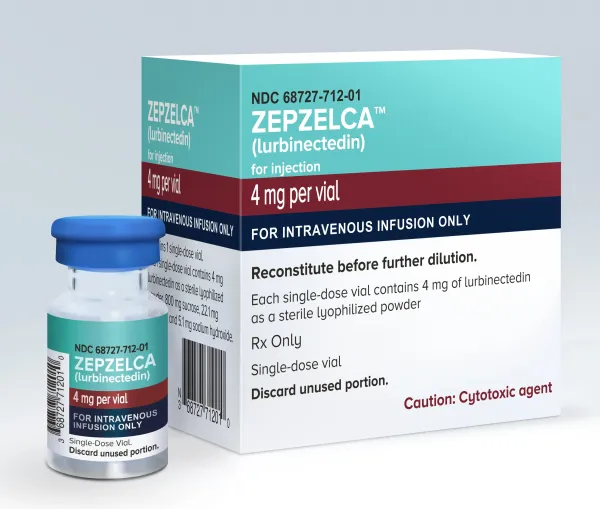Zepzelca Dosage
Generic name: LURBINECTEDIN .5mg in 1mL
Dosage form: injection, powder, lyophilized, for solution
Drug class: Alkylating agents
Medically reviewed by Drugs.com. Last updated on Jul 1, 2025.
Recommended Dosage
The recommended dosage of ZEPZELCA is 3.2 mg/m2 by intravenous infusion over 60 minutes every 21 days until disease progression or unacceptable toxicity.
Initiate treatment with ZEPZELCA only if absolute neutrophil count (ANC) is at least 1,500 cells/mm3 and platelet count is at least 100,000/mm3.
Dosage Modifications for Adverse Reactions
The recommended dose reductions for adverse reactions are listed in Table 1.
Permanently discontinue ZEPZELCA in patients who are unable to tolerate 2 mg/m2 or require a dose delay greater than two weeks.
|
Dose Reduction |
Total Dose |
|
First Second |
2.6 mg/m2 every 21 days 2 mg/m2 every 21 days |
Dosage modifications for ZEPZELCA for adverse reactions are presented in Table 2.
| a National Cancer Institute Common Terminology Criteria for Adverse Events (NCI CTCAE) version 4.0 | ||
| b Patients with isolated Grade 4 neutropenia (neutrophil count less than 500 cells/mm3) may receive G-CSF prophylaxis rather than undergo lurbinectedin dose reduction. | ||
|
Adverse Reaction |
Severitya |
Dosage Modification |
|
Neutropeniab |
Grade 4 or Any grade febrile neutropenia |
|
|
Thrombocytopenia |
Grade 3 with bleeding or Grade 4 |
|
|
Hepatotoxicity |
Grade 2 |
|
|
Grade ≥ 3 |
|
|
|
Rhabdomyolysis |
Grade 2 |
|
|
Grade ≥ 3 |
|
|
|
Other Adverse Reactions |
Grade 2 |
|
|
Grade ≥ 3 |
|
|
2.3 Dosage Modifications for Use with Strong and Moderate CYP3A Inhibitors
Avoid coadministration of ZEPZELCA with strong or moderate CYP3A inhibitors. If coadministration of ZEPZELCA with a strong or moderate CYP3A inhibitor cannot be avoided, reduce the dose of ZEPZELCA by 50%. After discontinuation of a strong or moderate CYP3A inhibitor for 5 half-lives of the inhibitor, increase the ZEPZELCA dose to the dose used before starting the inhibitor.
2.4 Dosage Modifications for Patients with Severe and Moderate Hepatic Impairment
Avoid administration of ZEPZELCA in patients with severe hepatic impairment (total bilirubin > 3 × Upper Limit of Normal (ULN)). If administration of ZEPZELCA cannot be avoided, the recommended dosage is 1.6 mg/m2 by intravenous infusion over 60 minutes every 21 days until disease progression or unacceptable toxicity.
In patients with moderate hepatic impairment (total bilirubin > 1.5 to ≤ 3 × ULN and any AST), the recommended dosage of ZEPZELCA is 1.6 mg/m2 by intravenous infusion over 60 minutes every 21 days until disease progression or unacceptable toxicity.
Premedication
Consider administering the following pre-infusion medications for antiemetic prophylaxis:
- •
- Corticosteroids (dexamethasone 8 mg intravenously or equivalent)
- •
- Serotonin antagonists (ondansetron 8 mg intravenously or equivalent)
Preparation, Administration and Storage
ZEPZELCA is a hazardous drug. Follow applicable special handling and disposal procedures1.
Preparation
- •
- Inject 8 mL of Sterile Water for Injection USP into the vial, yielding a solution containing 0.5 mg/mL lurbinectedin. Shake the vial until complete dissolution.
- •
- Visually inspect the solution for particulate matter and discoloration. The reconstituted solution is a clear, colorless or slightly yellowish solution, essentially free of visible particles.
- •
- Calculate the required volume of reconstituted solution as follows:
- •
- For administration through a central venous line, withdraw the appropriate amount of reconstituted solution from the vial and add to an infusion container containing at least 100 mL of diluent (0.9% Sodium Chloride Injection USP or 5% Dextrose Injection USP).
- •
- For administration through a peripheral venous line, withdraw the appropriate amount of reconstituted solution from the vial and add to an infusion container containing at least 250 mL of diluent (0.9% Sodium Chloride Injection USP or 5% Dextrose Injection USP).
Administration
- •
- Parenteral drug products should be inspected visually for particulate matter and discoloration prior to administration, whenever solution and container permit. If particulate matter is observed, do not administer.
- •
- ZEPZELCA can be administered with or without an in-line filter. If infusion lines containing in-line filters are utilized for administration of ZEPZELCA, polyethersulfone (PES) in-line filters with pore sizes of 0.22 micron are recommended.
- o
- Do not use in-line nylon membrane filters when the reconstituted ZEPZELCA solution is diluted using 0.9% Sodium Chloride Injection, USP. Adsorption of ZEPZELCA to the Nylon membrane filters has been observed when 0.9% Sodium Chloride Injection, USP is used as the diluent.
- •
- Compatibility with other intravenous administration materials and the diluted ZEPZELCA solution has been demonstrated in the following materials:
- o
- Polyolefin containers (polyethylene, polypropylene and mixtures).
- o
- Polyvinyl Chloride (PVC) (non-DEHP-containing), polyurethane and polyolefin infusion sets (polyethylene, polypropylene and polybutadiene).
- o
- Implantable venous access systems with titanium and plastic resin ports and with polyurethane or silicone intravenous catheters.
- •
- Do not co-administer ZEPZELCA and other intravenous drugs concurrently within the same intravenous line.
Storage of Infusion Solution
- •
- If not used immediately after reconstitution or dilution, the ZEPZELCA solution can be stored prior to administration for up to 24 hours following reconstitution, including infusion time, at either room temperature/ ambient light or under refrigeration at 2ºC to 8ºC (36ºF to 46ºF) conditions.
More about Zepzelca (lurbinectedin)
- Check interactions
- Compare alternatives
- Pricing & coupons
- Drug images
- Side effects
- During pregnancy
- FDA approval history
- Drug class: alkylating agents
- En español
Patient resources
Professional resources
Related treatment guides
See also:
Further information
Always consult your healthcare provider to ensure the information displayed on this page applies to your personal circumstances.



